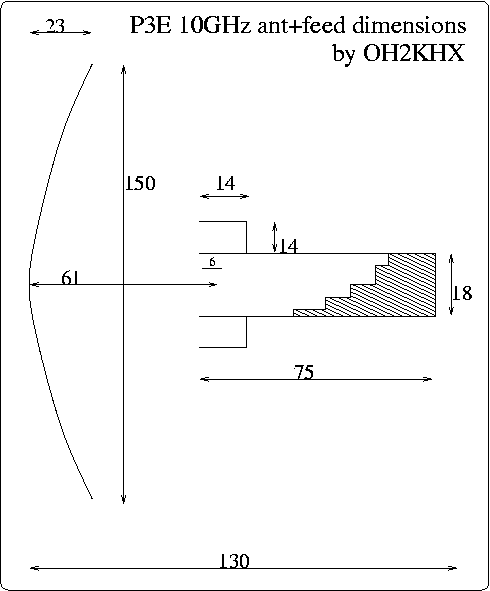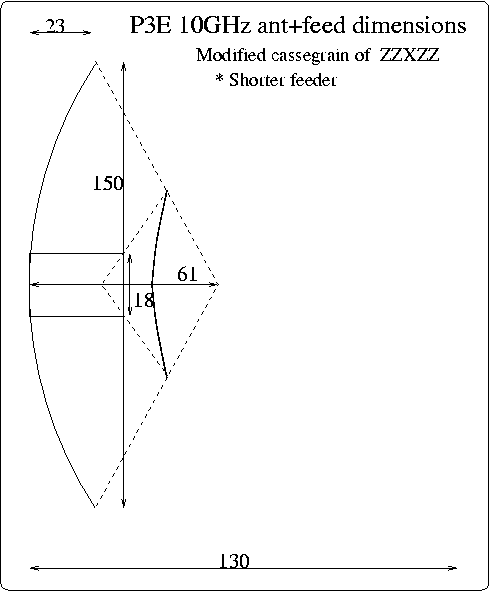P3E 10GHz prime-focus septum-fed dish antenna
A POVRAY rendered rough model of a 10GHz antenna for P3E satellite. (Of this source file.)Operational parameters:
Mid freq: 10.495 GHz (design guess) Bandwidth: 500 kHz (minimum) PEP: 8 W
![[img:p3e-10g-ant-primefocus.jpg]](p3e-10g-ant-primefocus.jpg)
(A PNG version of the same: PNG image)

Notes:
- The model is EXTREMELY ROUGH, as can be seen in many details, like at the approximation of the parabolic reflector with a thin shell of a sphere.
- Checker-patterns are 10.0 x 10.0 millimeters, height indication rulers are not part of the antenna.
- The prime focus located polarisation circularisation by a septum structure is simply presented as a solid blue cylinder without inner details. Same with the scalar choke.
- Position and dimensions of the feed are approximations for
model use, not for construction. They should be within 5 mm.
- Actual total height is about 130 mm with septum feed.
- Feed support structure is presented simply by red "wires" to
four directions, while in reality it would be something else,
like dielectric FR4 board.
A hardline coaxial feed must be routed along one edge of those. - Alternate injection methods into a round waveguide do exist which are very short, and produce circular (RHCP or LHCP) polarized signal. System could be shortened by about the length of the septum. (About 40 mm.)
- The picture has two yellow "wires" that represent collimated beam.
- There are two light sources:
- one is at 4m distance along Z-axis and shows choke-ring size as its shadow
- other is some 6m away general illuminizer
"Cassegrain" feed

In original installment, the septum-feeder punched thru the main mirror.
Here the feeder is shorter and fits inside the dish -- maybe..
Coax to waveguide transition producin circular polarisation without Septum

- Instead of normal "quarter-lambda probe", this has one lambda long broken loop
- The transition must be quarter-lambda from back-end, and can be(?) as close as a quarter-lambda from open end. => Feed can be made short.
- Practically the feed loop must be behind possible radial choke, which is half-lambda deep.
- This can possibly do the original cassegrain-like feed without backside protrusion.
- The feed loop needs mechanical support, e.g. poly-urethane foam.
- US005025264.pdf Marconi's flat CP-antenna (array) manufacturable out of PCB laminates.
A more traditional approach is to use two 1/4-lambda probes 90 degrees apart, and feed them:
- from a 90 degree hybride and thru equal length cables,
- or thru a two output 3 dB divider and cables with lengths of L and L + 1/4-lambda.